
The Minnesota Transportation Museum is a transportation museum in Saint Paul, Minnesota, United States.

The Como-Harriet Streetcar Line (CHSL) is a heritage streetcar line in Minneapolis, Minnesota, which follows original streetcar right-of-way between Lake Harriet and Bde Maka Ska and is operated by the Minnesota Streetcar Museum. The heritage line was originally developed in the 1970s by the Minnesota Transportation Museum which spun off streetcar operations in the winter of 2004–2005.
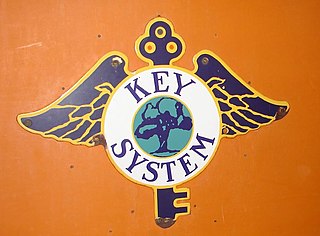
The Key System was a privately owned company that provided mass transit in the cities of Oakland, Berkeley, Alameda, Emeryville, Piedmont, San Leandro, Richmond, Albany, and El Cerrito in the eastern San Francisco Bay Area from 1903 until 1960, when it was sold to a newly formed public agency, AC Transit. The Key System consisted of local streetcar and bus lines in the East Bay, and commuter rail and bus lines connecting the East Bay to San Francisco by a ferry pier on San Francisco Bay, later via the lower deck of the Bay Bridge. At its height during the 1940s, the Key System had over 66 miles (106 km) of track. The local streetcars were discontinued in 1948 and the commuter trains to San Francisco were discontinued in 1958. The Key System's territory is today served by BART and AC Transit bus service.

The Philadelphia and Western Railroad was a high-speed, third rail-equipped, commuter-hauling interurban electric railroad operating in the western suburbs of the U.S. city of Philadelphia, Pennsylvania. It is now SEPTA's Norristown High Speed Line, though the Strafford spur has been abandoned. Part of the abandoned line within Radnor Township is now the Radnor Trail, a multi-use path or rail trail.
The Toronto Suburban Railway was a Canadian electric railway operator with local routes in west Toronto, and a radial (interurban) route to Guelph.
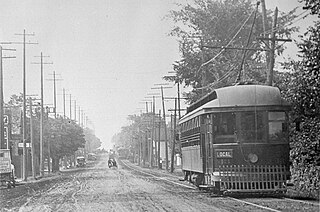
The Metropolitan Street Railway was the operator of the Metropolitan line in the Toronto area that started out as a local horsecar line and transformed itself into an electric radial line extending to Lake Simcoe, following an old stage coach route. In 1904, the railway was acquired by the Toronto and York Radial Railway (T&YRR) and became the T&YRR Metropolitan Division. In 1922, the City of Toronto acquired the T&YRR and contracted Ontario Hydro to manage the four T&YRR lines including the Metropolitan. In 1927, the TTC took over the operation of the Metropolitan Line to Sutton, and renamed it the Lake Simcoe line. In 1930, the TTC closed the Metropolitan Line but shortly reopened the portion between Glen Echo and Richmond Hill operating it as the North Yonge Railways until 1948.

The Davisville Subway Yard is a rail yard on the Toronto Transit Commission's Yonge subway line. The train maintenance and storage building is referred to as the Davisville Carhouse.

The Connecticut Trolley Museum, founded in October 1940, is the oldest incorporated museum dedicated to electric railroading in the United States. The museum is located in East Windsor, Connecticut and is open to the public April through December. The museum features static and moving displays, and self-guided tours of the state's trolley history.

The Illinois Railway Museum is the largest railroad museum in the United States. It is located in the Chicago metropolitan area at 7000 Olson Road in Union, Illinois, 55 miles (89 km) northwest of downtown Chicago.

The Fort Collins Municipal Railway operated streetcars in Fort Collins, Colorado, from 1919 until 1951. Since 1984, a section of one of the former routes has been in operation as a seasonal heritage streetcar service, under the same name, running primarily on Spring and Summer weekends. The heritage service is operated by volunteers from the Fort Collins Municipal Railway Society (FCMRS). The streetcar in use on the heritage line, Birney "Safety" Streetcar No. 21, is listed on the National Register of Historic Places.

The Lake Shore Electric Railway (LSE) was an interurban electric railway that ran primarily between Cleveland and Toledo, Ohio by way of Sandusky and Fremont. Through arrangements with connecting interurban lines, it also offered service from Fremont to Fostoria and Lima, Ohio, and at Toledo to Detroit and Cincinnati.

Pittsburgh Railways was one of the predecessors of Pittsburgh Regional Transit. It had 666 PCC cars, the third largest fleet in North America. It had 68 streetcar routes, of which only three are used by the Port Authority as light rail routes. With the Port Authority's Transit Development Plan, many route names will be changed to its original, such as the 41D Brookline becoming the 39 Brookline. Many of the streetcar routes have been remembered in the route names of many Port Authority buses.

The Pennsylvania Trolley Museum is a museum in Washington, Pennsylvania, dedicated to operation and preservation of streetcars and trolleys. The museum primarily contains historic trolleys from Pennsylvania, but their collection includes examples from nearby Toledo, Ohio; New Orleans, and even an open sided car from Brazil. Many have been painstakingly restored to operating condition. Other unique cars either waiting for restoration or incompatible with the Pennsylvania trolley gauge track are on display in a massive trolley display building. Notable examples on static display include a J.G. Brill “brilliner” car which was introduced as a competitor to the PCC, locomotives, and a horse car from the early days of Pittsburgh’s public transit systems.

The National Capital Trolley Museum (NCTM) is a 501(c)(3) nonprofit organization that operates historic street cars, trolleys and trams for the public on a regular schedule. Located in Montgomery County, Maryland, the museum's primary mission is to preserve and interpret the history of the electric street and interurban railways of the National Capital region.
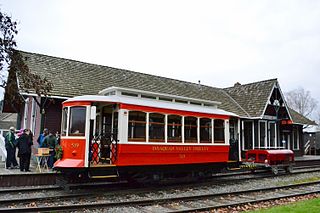
The Issaquah Valley Trolley (IVT) was a heritage streetcar line in Issaquah, Washington, United States. It was a project of the Issaquah History Museums. The IVT operated from the Issaquah Depot Museum building located at 78 First Ave, NE. The service operated on a trial basis in 2001–02 and then on a regular basis, seasonally, from 2012 to 2020.

The Oregon Electric Railway Museum is the largest streetcar/trolley museum in the Pacific Northwest of the United States. It is owned and operated by the Oregon Electric Railway Historical Society and is located in Brooks, Oregon, on the grounds of Powerland Heritage Park.
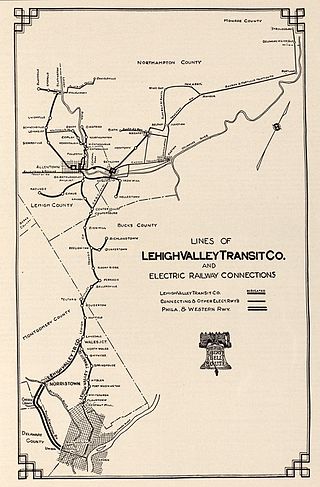
The Lehigh Valley Transit Company (LVT) was a regional transport company, headquartered in Allentown, Pennsylvania, that began operations in 1901 as an urban trolley and interurban rail transport company. It operated successfully into the 1930s, struggled financially during the Great Depression, and was saved from abandonment by a dramatic ridership increase due to the Second World War. In 1951, the LVT, once again financially struggling, ended its 36-mile (58 km) interurban rail service from Allentown to Philadelphia. In 1952, it ended its Allentown area local trolley service. It operated local bus service in the Allentown, Bethlehem, and Easton, Pennsylvania, areas until going out of business in 1972.

The Lake Shore Electric Railway was an attempt to start an electric railway museum in Cleveland, Ohio.
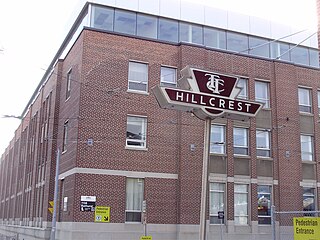
Hillcrest Complex is the Toronto Transit Commission's largest facility and is responsible for most of the maintenance work on the system's surface vehicles, including heavy overhauls, repairs and repainting. It is located adjacent to the intersection of Bathurst Street and Davenport Road. The site is also home to the TTC's Transit Control Centre, but the operational headquarters of the organization remain at the McBrien Building at 1900 Yonge Street.

The Southern California Railway Museum, formerly known as the Orange Empire Railway Museum, is a railroad museum in Perris, California, United States. It was founded in 1956 at Griffith Park in Los Angeles before moving to the former Pinacate Station as the "Orange Empire Trolley Museum" in 1958. It was renamed "Orange Empire Railway Museum" in 1975 after merging with a museum then known as the California Southern Railroad Museum, and adopted its current name in 2019. The museum also operates a heritage railroad on the museum grounds.




















